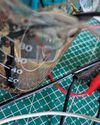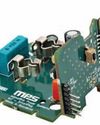"The Core Issue With ADAS Is Not Just Automotive Technology But An AI Challenge"
Electronics For You
|September 2024
India’s roads push ADAS to its limits. Can we innovate solutions and lead in safer driving? In this Q&A, EFY’s Mukul Kumar explores this with Gagandeep Reehal, the 23-year-old CEO and Co-founder of Minus Zero.
-

What are the different categories of ADAS relevant to India, and why has its adoption been challenging compared to other countries?
Advanced driver assistance systems (ADAS) vary in complexity from level 0 to level 5 autonomy. Level 0 (L0) represents standard vehicles where the driver controls all functions. Level 1 (L1) includes basic warning features, such as lane departure alerts. Level 2 (L2) introduces automation, including lane-keeping assist and adaptive cruise control, using systems like Mobileye, now prevalent in vehicles from brands such as Mahindra.
The challenge of adopting ADAS in India, compared to other countries, arises from the country’s unique road conditions. Inconsistent or absent lane markings, diverse vehicle types, and unpredictable road scenarios hinder the effectiveness of ADAS technologies, which rely on consistently detecting markers and obstacles. Moreover, substantial global investments in ADAS research and development (R&D) have not yet translated effectively to Indian roads, where the variability and complexity far exceed typical test environments. This situation has posed significant challenges in creating reliable systems that can adapt to India’s diverse traffic conditions, like the leap from basic chatbots to more advanced AI models like ChatGPT and large language models (LLMs).
Can you describe your journey in identifying and addressing the challenges with ADAS, especially in environments without clear infrastructure, such as missing lane markings in India?
यह कहानी Electronics For You के September 2024 संस्करण से ली गई है।
हजारों चुनिंदा प्रीमियम कहानियों और 10,000 से अधिक पत्रिकाओं और समाचार पत्रों तक पहुंचने के लिए मैगज़्टर गोल्ड की सदस्यता लें।
क्या आप पहले से ही ग्राहक हैं? साइन इन करें
Electronics For You से और कहानियाँ

Electronics For You
Tech Majors Are Racing TOWARDS NET-ZERO - What About You?
Apple, Microsoft, Amazon, Google, Infosys, Wipro—global and Indian firms are heading closer to achieving net-zero emissions, a mandate to combat climate change. Here is what you need to know to start your journey...
12 mins
December 2025

Electronics For You
Miniature IoT WATER TDS And LEVEL MONITOR Cum CONTROLLER
For setups that rely on stored water, clear awareness of tank level and water quality is essential.
3 mins
December 2025

Electronics For You
The Impact Of GENERATIVE AI On The Future Of AUTOMOTIVE AND EVs
Autonomous vehicles, connected ecosystems, and smart factories are only the beginning. Generative Al is pushing the auto industry beyond predictions into a bold era of creativity-from EV design to real-time diagnostics and showroom automation. Here is how GenAl is reshaping innovation across the automotive value chain.
8 mins
December 2025

Electronics For You
How AI Tools Are Making SOFTWARE DEVELOPMENT BETTER
AI is reshaping how we code, debug, and collaborate. From Copilot to automation, it is changing software development in ways worth exploring.
3 mins
December 2025
Electronics For You
How AI Tools Are Making SOFTWARE DEVELOPMENT BETTER
AI is reshaping how we code, debug, and collaborate. From Copilot to automation, it is changing software development in ways worth exploring.
3 mins
December 2025

Electronics For You
5 Interesting Reference Designs FOR SMART HOMES
Smart home devices are transforming the way people interact with their appliances. They make homes more convenient, secure, and energy-efficient. From smart plugs and energy monitors to smart locks and thermostats, reference designs help design engineers create connected products that are easy to use, consume less power, and are reliable. These designs allow you to control devices remotely, track energy use, extend battery life, and automate routines. They provide practical solutions for upgrading homes and small commercial spaces without major modifications.
3 mins
December 2025

Electronics For You
Fancy USB LED VASE
This USB LED vase is a simple yet elegant device that fuses art with electronics to create a decorative lighting display. Powered directly from a standard USB port, it uses readily available components such as MOSFETs, resistors, capacitors, and LEDs to produce a striking, dynamic sequence of lights.
3 mins
December 2025

Electronics For You
"WHAT OTHERS SELL IN FOUR BOXES WE BUILT IN ONE"
Years of custom field work are shaping a product line with its own cloud, its own hardware, and a market that is now beginning to recognise its value.
8 mins
December 2025

Electronics For You
BUILD LARGE LANGUAGE MODELS
Large language models are machine learning models designed for a range of language-related tasks such as text generation and translation. Here’s how open source software can help you build your own large language model.
6 mins
December 2025

Electronics For You
Rare Earth Or Rare Ingenuity? India Remains Between The Two
With China firmly controlling rare earth exports, India confronts a critical moment in its technological trajectory.
8 mins
December 2025
Listen
Translate
Change font size

